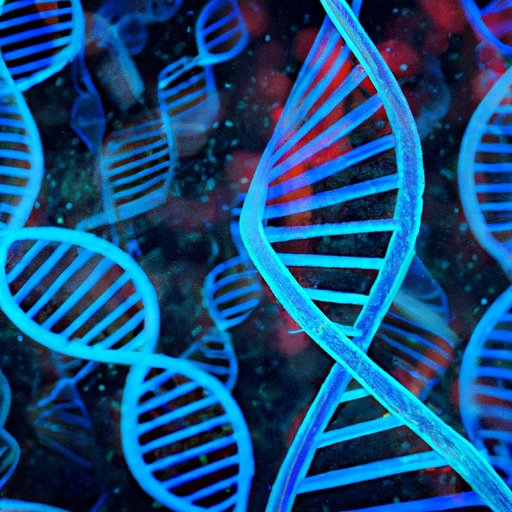Introduction
Since the discovery of the double helix structure of DNA in 1953, scientists have been working tirelessly to unravel the mysteries of the genetic code that governs life on Earth. DNA, genes, and chromosomes are all integral components of this code, and their complex relationship is essential to understanding how organisms develop and how they pass on their traits to future generations.
The Hidden Connection: Unveiling the Complex Relationship Between DNA, Genes, and Chromosomes
DNA, genes, and chromosomes all play a vital role in the genetic makeup of an organism. DNA, or deoxyribonucleic acid, is the chemical blueprint for life that dictates an organism’s structure and function. Genes are segments of DNA that carry the information needed to make specific proteins, which perform various tasks within the body. Chromosomes are structures that package and organize DNA, allowing it to be efficiently transported during cell division.
Genetic Puzzle: Understanding the Intricacies of DNA, Genes, and Chromosomes
The building blocks of DNA are nucleotides, which are made up of a sugar molecule, a phosphate group, and one of four nitrogenous bases (adenine, thymine, guanine, or cytosine). Nucleotides link to one another through chemical bonds, forming long chains that make up the structure of DNA. Genes are expressed through DNA when specific sequences of nucleotides are read by the cell and used to build proteins. Chromosomes organize the genetic information contained within DNA into unique structures, which are replicated during cell division.
The Building Blocks of Life: How DNA, Genes, and Chromosomes Work Together to Make Us Who We Are
The role of DNA in protein synthesis is essential to all life forms. Proteins serve as enzymes, hormones, receptors, and transporters, among other things. Genes determine physical and behavioral traits by providing the necessary information for the development and maintenance of tissues and organs. Chromosomes influence inheritance patterns by controlling which genetic traits are passed from parent to offspring. Disorders caused by abnormalities in DNA, genes, or chromosomes can result in serious health consequences, such as cancer, developmental disorders, and genetic disease.
From Genes to Chromosomes: Decoding the Blueprint of Life
Mapping the human genome was a landmark achievement in genetics research that paved the way for the development of tools and techniques for studying DNA, genes, and chromosomes in greater detail. Techniques such as CRISPR/Cas9 gene editing and next-generation sequencing are revolutionizing the field of genetics and opening up new avenues for research. Historical developments in genetics research, such as the discovery of the structure of DNA, have paved the way for future advancements that promise to unlock even more of the secrets of the genetic code.
Behind Every Trait: The Interdependent Relationship Between DNA, Genes, and Chromosomes
The relationship between DNA, genes, and chromosomes is intricate and interdependent, as each component relies on the others to carry out its function. The complexity of this relationship has far-reaching implications for human health, medicine, and society. With the power to manipulate DNA, comes ethical questions about how genetics research should be conducted and how genetic information should be used. However, the promise of genetic technology holds immense potential for treating and curing diseases and improving the quality of life for people around the world.
Conclusion
In conclusion, DNA, genes, and chromosomes are the fundamental components of the genetic code that governs life on Earth. The interdependent relationship between these components is essential to understanding how organisms develop and function. Advances in genetics research have paved the way for exciting developments in genetic technology that promise to unlock even more of the secrets of the genetic code. As we continue to decode the blueprint of life, we must remain conscious of the implications and potential consequences of our actions.
